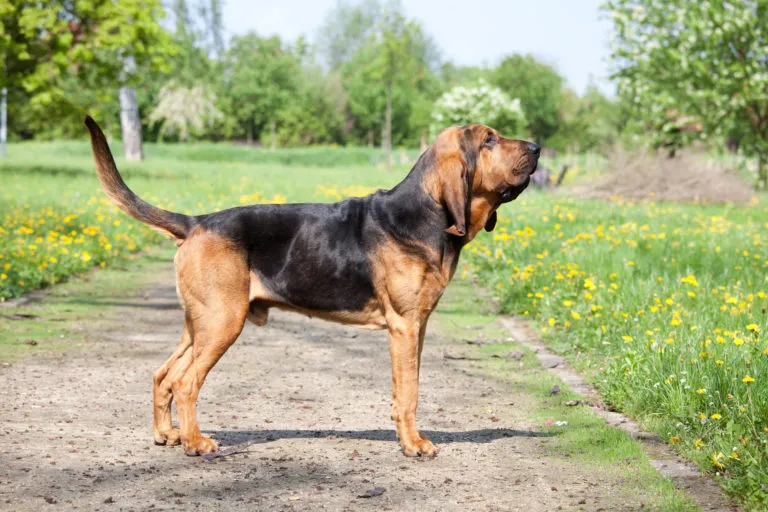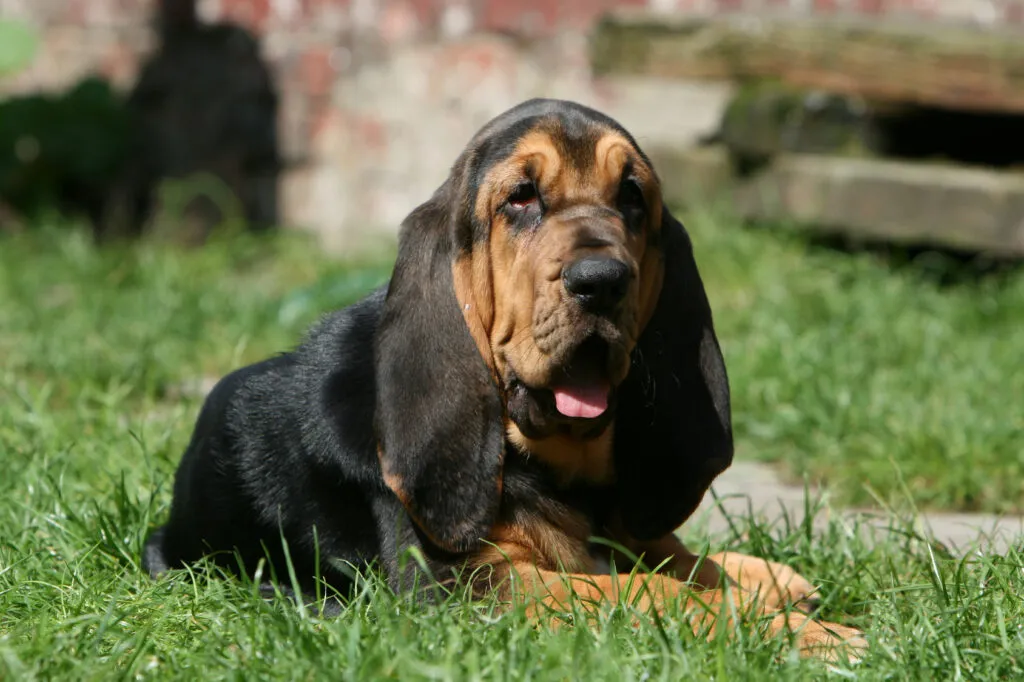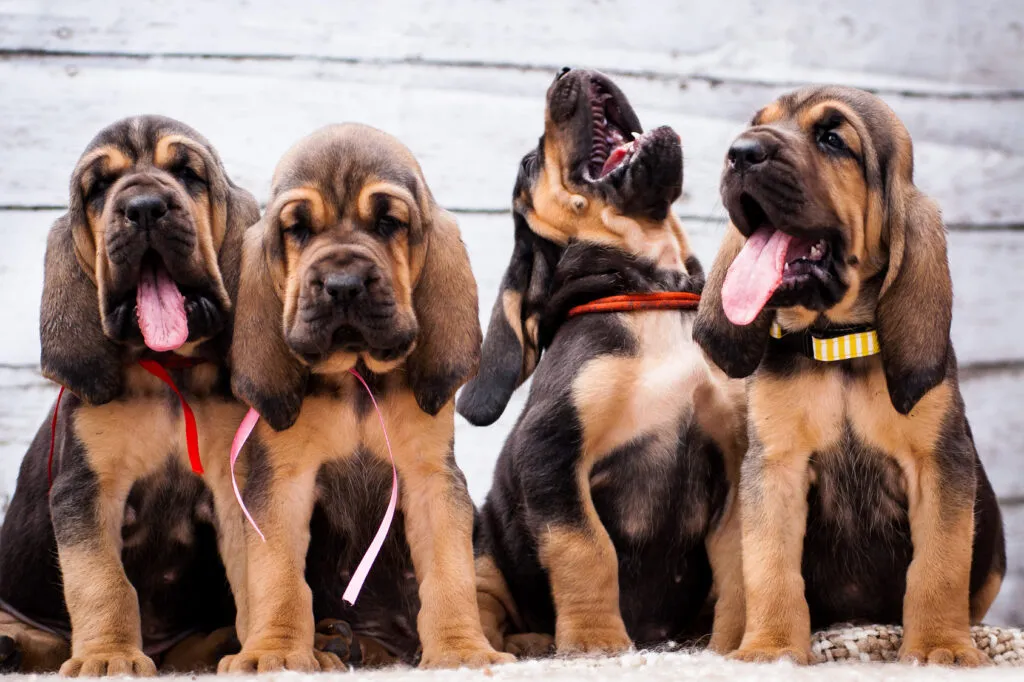Medium Size Poodle
The imposing Bloodhound is not only one of the oldest large scent hounds in the world but also has the best nose of any breed. This majestic dog can track a scent that's several days old. The Belgian breed is very sociable with people but also quite stubborn.

© lenkadan / stock.adobe.com
Its exceptionally good nose makes the Bloodhound a talented sniffer dog
Despite the calm and composed appearance of this gentle giant—with its long, drooping ears, deep wrinkles, and good-natured expression—once a Bloodhound picks up a scent, nothing can distract it, and it follows the trail obsessively.
As a “trailing dog”, it can follow the unique scent of an individual person for several days and over many kilometres. Its excellent nose, combined with an extraordinary ability to focus, makes it an exceptional tracking specialist.
Throughout its history, dating back to the 2nd century, the Bloodhound primarily gained fame as a tracking and pack dog for large game. This “Hubertushund”, bred by monks, is also sought after as a bloodhound for tracking wounded game. While it’s rare to find this large dog purely as a family pet, its gentle, friendly, and devoted nature makes it suitable for family life.
It is also highly sensitive, very tolerant of children, other pets, and other dogs, and always in a good mood, making it a pleasant companion and loyal friend. It is strongly attached to its owner but is usually very open and friendly to strangers. As a guard dog, the good-natured Bloodhound is completely unsuitable.
Its friendly nature and gentle demeanour shouldn’t mask the fact that a Bloodhound is very stubborn and switches off if it deems its owner’s commands unimportant. Novice dog owners might find this trait overwhelming, so experienced handlers who understand the specific quirks of this imposing breed are ideal.
This breed’s high sensitivity makes it extremely responsive to both praise and reprimand. The proud dog finds it hard to forgive undue harshness or injustice. Therefore, the right mix of consistency, love, and patience is essential in training, along with the ability to motivate the dog. A good dose of lenience is also helpful for harmonious living, especially when the Bloodhound ignores a command to follow a scent.
The Bloodhound is the most powerful scent hound in the world. To control this substantial and large hunting and tracking dog, you need substantial training, strength, and a long lead. Despite the slow and graceful movements of the large Belgian, it never loses its dignified, almost majestic appearance, even when chasing a deer.
Its rectangular, harmoniously built body is muscular and exudes dignity and strength without appearing clumsy.
Adult Bloodhounds can reach a shoulder height of up to 70cm and a weight of up to 50kg.
 © Dogs / stock.adobe.com
© Dogs / stock.adobe.com
Equally impressive as its size is its dense, short, and smooth fur, which hangs in deep wrinkles, though not so many as to compromise its health or functionality. Characteristic features include its thin, very long ears that hang down to its nose tip and its dark brown, oval eyes with a good-natured expression.
The Bloodhound’s tail matches its overall appearance—strong, long, and always carried in an arch. Another typical feature of this breed is its long neck, enabling it to lower its nose to the ground even while running.
Bloodhounds come in three colour varieties today: black and tan, liver and tan, and solid red.
The history of the Bloodhound is as impressive as its overall appearance. As early as the 2nd century, the ancestors of the Bloodhound are believed to have served the Gauls and Celts as hunting dogs. From the 7th century onwards, the black or black and tan hunting dogs were bred by monks at the Saint-Hubert Monastery in Belgium’s Ardennes—hence the name “Hubertushund”. The Belgian studbook still records it under this name.
The Belgian breed owes its name to the English, who brought some of these excellent hunting dogs to their homeland in the 11th century. The exact reason for the name “Bloodhound” remains unclear. Some believe it emphasises the purebred lineage of the dog, while others think it highlights its exceptional tracking ability.
Thanks to its excellent tracking and hunting abilities and robustness, the “Chien de Saint-Hubert” became popular beyond its Belgian origin. Up to the 16th century, Hubertushounds served in royal packs and were bred under various names in many places.
In Belgium, Luxembourg, and Germany, they became known as “Ardennes Hounds”, purely as hunting dogs. In the USA, the Bloodhound was cross-bred, resulting in the “Coonhound” in the 17th century. In the southern states, these skilled trackers were even used to pursue runaway slaves.
Today, the Bloodhound is a relatively rare breed. Though their training for police work is extensively promoted in the USA and Canada, and they are sometimes used for search and rescue in Europe, they are less desired as family and companion dogs due to their stubbornness. If you are still captivated by this fascinating breed and willing to face the challenges, you need to take the time to find a suitable and reputable breeder.
 © Sushytska / stock.adobe.com
© Sushytska / stock.adobe.com
A good first step is to contact the official national Bloodhound clubs, found in countries like the Netherlands, Belgium, Germany, France, England, and North America. Here, you can connect with Bloodhound owners and obtain a list of breeders with puppies. Before bringing a puppy home, get to know your chosen breeder through at least one or several visits.
Ask to see the mother dog and closely examine the breeding facility. Do the puppies grow up closely bonded with the family and are they socialised from the start? What impression does the breeder make? Are they likeable and do they willingly share their wealth of experience? Alongside official formalities like EU papers, pedigrees, microchips, and vaccination records, the personal relationship should also feel right.
Good breeders often maintain contact with the new puppy owners even after the purchase and provide ongoing advice and support. This can be very helpful, especially when you have questions or issues regarding your dog’s training, care, or nutrition.
A healthy puppy from a flawless, reputable breeding line is the best start to a long, trouble-free life for your dog. The average lifespan of this ancient breed is 10 to 12 years.
Joint diseases like hip dysplasia (HD) or elbow dysplasia (ED) are common problems during this time, as they are with many large breeds. Because these issues are often hereditary, the puppy should come from an HD-free lineage. Many health problems can also be avoided with proper nutrition and suitable living conditions.
Further health issues in Bloodhounds can stem from eye diseases like entropion, ectropion or cherry eye. Bloodhounds can also suffer from skin inflammations in their deep wrinkles.
Good health for your dog is greatly influenced by proper constitution. Many issues can be avoided with the proper amount of exercise, good care, and a healthy, balanced diet. Joint problems often become evident in a dog’s later years, but the roots of these issues frequently trace back to puppyhood.
Overuse of joints due to improper exercise (e.g., frequent stair climbing when the dog is a puppy), overfeeding, or poor nutrition can cause joint issues later. Hence, ensure your dog gets food suitable for its age and weight from the start.
Both overfeeding and underfeeding in terms of nutrients can lead to serious health problems. The energy and nutrient content of the food should always be tailored to the dog’s age, weight, and activity level. For example, too much protein in puppyhood can cause the joints to grow too quickly.
Additionally, a lack of calcium and phosphorus in puppy food can lead to later skeletal diseases. Discussing the specific needs of your dog with a veterinarian can help you create an optimal feeding plan.
Another issue with many Bloodhounds is overweight, since they are often voracious eaters. Aside from improper or overly calorific diets, other factors like castration, thyroid underactivity, overactive kidneys, advanced age, or lack of exercise can cause unwanted weight gain.
Before addressing the issue with a diet or more exercise, have your dog examined by a veterinarian to determine if the weight gain is due to poor diet or another condition requiring special treatment. Set fixed feeding times (one to two meals per day) and a fixed daily amount, avoiding too many treats between meals, to maintain a healthy diet.
Compared to proper nutrition and training, caring for your Bloodhound is straightforward. The breed’s short, weatherproof fur is extremely easy to care for and only needs occasional brushing. Additionally, regularly checking and cleaning your dog’s eyes and ears if necessary can prevent inflammations and detect potential diseases early.
Keeping such a large and specific dog like the Bloodhound requires more than just good care and the right dog food. Primarily, a large dog like the Hubertushund needs plenty of space. A city flat is definitely not suitable for a Bloodhound. These dogs thrive in rural, peaceful environments, away from street noise and large crowds.
A detached house with a large garden is ideal for this nature-loving dog, which might also prefer sleeping in an outdoor doghouse. Make sure your property is securely fenced to prevent your dog from wandering off on its own, following a scent trail.
To keep your Bloodhound happy, you need to provide ample opportunities for exercise and physical activity. Ideal for this breed with the world’s best tracking nose is, of course, tracking work. Bloodhounds kept as pure family pets, unable to pursue their passion professionally, need sufficient substitute activities. Prospective owners should consider which activities to engage in with their dog before making a purchase.
Apart from time and experience, owners should be creative and enjoy physical activities. A special sense of humour and a degree of leniency regarding obedience and cleanliness (Bloodhounds drool a lot) are also very helpful for a happy and carefree life with a Bloodhound.
Fans of the Bearded Collie agree that those who aren't familiar with this dog breed simply have to get acquainted with it. And those who have experienced how a Bearded Collie bolts across meadows with its flowing fur, how it rolls around full of energy and joy and how it attentively and observantly takes into account its owners wishes become simply addicted to this original dog breed and its unique charm.
The Goldendoodle isn't a breed, but a pairing between Golden Retrievers and Medium or Standard Poodles. Marketed as a low-maintenance dog for allergy sufferers, this hybrid is enjoying increasing popularity amongst dog lovers, similar to the Labradoodle.